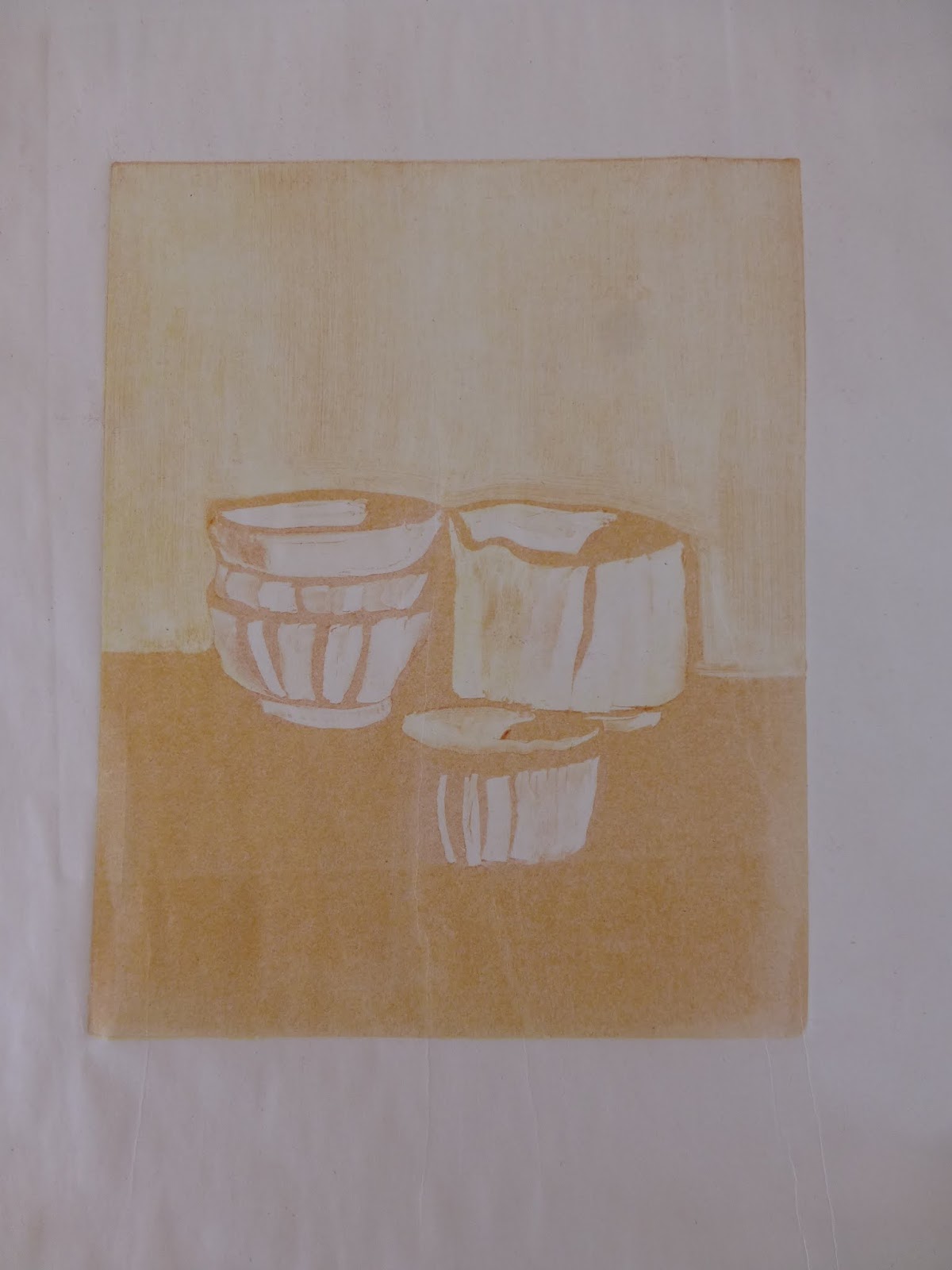 This is so much fun, but it's been a long time since I tried it, and then only once. So I started by borrowing a composition from the work of Giorgio Morandi, one of my favorite painters, which allowed me to focus on the techniques involved. Placing the image under my plexiglass plate, I first rolled out a layer of yellow paint, and duly wiped out areas where I wanted no yellow. I ran this through the press onto my moistened paper. Then I did the same with an orangish color. A print on newsprint off the "ghost" of this plate (the paint that remained after being run through the press) appears at left.
This is so much fun, but it's been a long time since I tried it, and then only once. So I started by borrowing a composition from the work of Giorgio Morandi, one of my favorite painters, which allowed me to focus on the techniques involved. Placing the image under my plexiglass plate, I first rolled out a layer of yellow paint, and duly wiped out areas where I wanted no yellow. I ran this through the press onto my moistened paper. Then I did the same with an orangish color. A print on newsprint off the "ghost" of this plate (the paint that remained after being run through the press) appears at left.Finally, I created a plate the same way with blue paint, and ran it through onto the paper, creating a three-layer monotype (see above). The ghost of this final plate after it was run through the press is shown below, with the colors from the two earlier passes still lurking below the blue. The image on the plate, of course, is the mirror image of the print.
 A major challenge in multiple pass monotypes is that of registration, or lining up second and later plates to print exactly on top of the first pass. There are many ways to do this, from marking a piece of newsprint with the corners or the centers of the plate, and being sure that each sequential plate is lined up correctly, to elaborate grids permanently installed on the press bed. I chose a middle path, and am using an 18" x 24" piece of quarter-inch grid graph paper. Having purchased a pad of this paper, I started out creating a registration sheet for each monotype, but today I created a master sheet, as it were, by marking a center vertical line and marks for 1-1/2 and 2 inch top borders. The quarter-inch grid makes it easy to set both plate and paper down evenly. I put a clear piece of plexiglass, the same width as the press bed, on top of this master registration sheet, and I now have a cleanable, multi-purpose base on which to line up my plates and papers. I can remove it at any time; I just have to increase or lessen the pressure of the press to account for its thickness.
A major challenge in multiple pass monotypes is that of registration, or lining up second and later plates to print exactly on top of the first pass. There are many ways to do this, from marking a piece of newsprint with the corners or the centers of the plate, and being sure that each sequential plate is lined up correctly, to elaborate grids permanently installed on the press bed. I chose a middle path, and am using an 18" x 24" piece of quarter-inch grid graph paper. Having purchased a pad of this paper, I started out creating a registration sheet for each monotype, but today I created a master sheet, as it were, by marking a center vertical line and marks for 1-1/2 and 2 inch top borders. The quarter-inch grid makes it easy to set both plate and paper down evenly. I put a clear piece of plexiglass, the same width as the press bed, on top of this master registration sheet, and I now have a cleanable, multi-purpose base on which to line up my plates and papers. I can remove it at any time; I just have to increase or lessen the pressure of the press to account for its thickness.This was such a satisfying exercise, and I plan to incorporate the method into my stable of techniques as I move forward. That said, I created a second triple-pass monotype that turned out badly. In addition to registration being off, the colors did not work well. I think there must be guidelines to follow in terms of what colors to use, and in what order. It is evident from my Morandi piece that combinations other than the three primaries will work, but not just any combination.
Graph Paper 1/4" grid, 18" x 24"
No comments:
Post a Comment